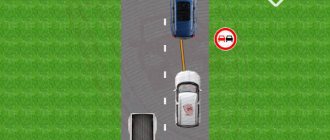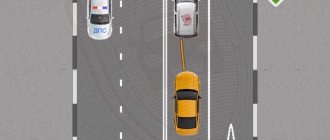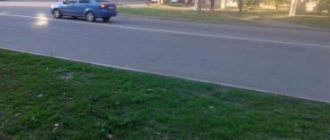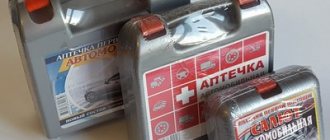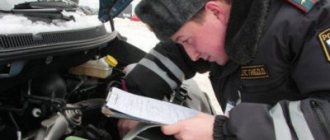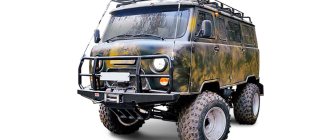Motorists regularly face problems. In order not to be left alone in a situation where there is no one to help, we have to help each other: constantly “pick out” a car stuck in thick mud, or, with three of us leaning on it, push the car to start it. And you also have to tow it when you really can’t start it.
Typically, this action requires the use of a tow rope. There are often cases when a rigid coupling for passenger cars has to be used even for ordinary cars. One of the most common traffic rules in this matter is that if the brake system fails, towing with a flexible hitch cannot be used. What to do in such ridiculous situations?
The best way to solve the problem is towing with a rigid hitch. It will allow you to maintain a certain distance between cars, eliminating any possibility of an accident during braking. There are several options for rigid coupling: with two fastening points and with three. Before we look at them in detail, let's first understand the requirements for towing with a rigid hitch according to the rules of the road.
TYPES, MAIN PARAMETERS AND DIMENSIONS
1.1.
Depending on the design, it is necessary to distinguish between towing devices of the “rod - towing fork” and “triangle - towing forks” types. * The constructive gross weight of a truck tractor should be understood as the sum of the curb weight of the truck tractor and the saddle weight set by the manufacturer, as well as the regulated weights of the driver and maintenance personnel according to the number of seats in the cab.
1.2. The standard size of the towing device must be determined depending on the design gross weight of the towed vehicle in accordance with the table.
Structural gross weight of the towed vehicle, kg
Height of the longitudinal axis of the towing fork
St. 3500 to 19000
St. 14500 to 35000
* The specific value is established by agreement between the manufacturer and the consumer (customer).
1.3. The main dimensions of the towing fork with a kingpin must correspond to those indicated in the drawing. 1 and in the table.
Note. The design of the towing fork with a kingpin is not regulated by the drawing.
1.4. On all types of vehicles, except off-road vehicles, one or two towing forks must be installed, and on all-terrain vehicles, two towing forks are required. Towing forks must be located either in the vertical longitudinal plane of symmetry of the car (one fork), or symmetrically relative to it at a distance of 570 to 1150 mm between the axes of the pins (two forks), and the axis of the fork (forks) must be parallel to the longitudinal axis of the car.
By agreement between the manufacturer and the consumer (customer), a different number and location of towing forks is allowed.
1.5. The height of the longitudinal axis of the towing fork(s) from the supporting surface for vehicles of all types, except buses, must correspond to that indicated in the table, and for buses - set by agreement between the manufacturer and the consumer (customer).
1. The design of the tug is not regulated by the drawing.
2. Deviation of hinge sizes according to GOST 7505.
1.6. The dimensions of tugs and their loops must correspond to those indicated in the drawing. 2 and in the table. For tugs of the “rod” type of sizes 1-3, by agreement between the manufacturer and the consumer (customer), it is allowed, and for a tug of size 4, the same dimensions of the loops at both ends of the tug are required, which must correspond to those indicated in Fig. 2 for a loop that is coupled to the towing device of the towing vehicle.
For tugs of the “triangle” type, the design of which has built-in hinges with a horizontal axis of rotation, the dimensions of the hinges engaged with the towing forks can be established by agreement between the manufacturer and the consumer (customer).
For international transport, the dimensions of the tug loop connected to the towing device of the towing vehicle must comply with ST SEV 5165.
The design of the delta tug should allow for changes in size C
within the limits specified in the table.
GENERAL TECHNICAL REQUIREMENTS
2.1. Elements of the towing device (towing forks and rigid tugs) must be manufactured in accordance with the requirements of this standard according to regulatory and technical documentation.
2.2. The structural dimensions and shapes of the elements of towing devices, the material and method of manufacture, as well as the place and method of attaching the towing fork (towing forks) to the vehicle and the method of locking the kingpin should be established in the regulatory and technical documentation based on the results of strength calculations and operating experience.
2.3. The hardness of the mating working surfaces of the towing loop and the fork pivot must be at least HRC e 43.
2.4. Towing forks should not protrude beyond the dimensions of the vehicle, and their design and location should ensure the possibility of free deflection of the attached tow relative to the longitudinal axis of the vehicle:
in the vertical plane (angle a of Fig. 1) at an angle of at least ±15°, and for off-road vehicles at an angle of at least ±45°. The last requirement can be satisfied by the design of the tug;
in the horizontal plane (angle β, drawing 1) for a rod-type tug at an angle of at least ±50°.
By agreement between the manufacturer and the consumer (customer), other angles of free deflection of the attached tug are allowed.
For a tugboat made with the same hinge dimensions in accordance with clause 1.6, its free deflection angles are established by agreement between the manufacturer and the consumer (customer).
2.5. The design dimensions and shape of the towing fork must ensure the ability to couple with a cable, chain or rope when pulling out a stuck vehicle or securing a vehicle for transportation on another vehicle.
2.6. The king pin must be positioned vertically and fit with guaranteed clearance in the towing fork holes. The design of the kingpin locking must exclude the possibility of spontaneous detachment of the tug during movement and not prevent it from deflecting within the limits of the angles provided for in paragraph 2.4.
2.7. The tug's coupling loops must be fixedly fixed and installed in the same plane. For a “rod” type tug, the mutual deviation of the hinge planes is allowed to be no more than 3°. For a “triangle” type tug, when supported on a common plane, the non-perpendicularity of the axis of each coupling loop of the tug to this plane should be no more than 3°.
2.8. The tug should be painted with red and white alternating transverse stripes 240-260 mm wide.
At the request of the consumer (customer), monochromatic dark colors are allowed.
2.9. The following must be marked on the tugboat:
maximum structural gross weight of the towed vehicle in tons;
manufacturer's trademark;
control service stamp;
month and year of production of the tug.
Rules for towing with a rigid hitch
Towing a vehicle with a rigid hitch
Is it possible to tow a car with an automatic transmission? You can read here
First of all, traffic regulations prohibit towing in any case if the steering of the towed vehicle is faulty - it can only be transported by partial or full loading. Sometimes they write that when hitching with three attachment points, it is not necessary for the driver to be behind the wheel of the towed car - this is an erroneous idea that contradicts the requirements of the traffic rules. The driver of the towing vehicle must have at least 2 years of driving experience. The dimensions of the rigid coupling must be such that the distance between the machines is no more than 4 meters. The weight of a towed vehicle with a non-working brake system should not exceed half the weight of the “tug”.
Advantages of a rigid hitch
Compared to a flexible coupling, a rigid one has a lot of undeniable advantages. Firstly, there is no jerk, and the transported vehicle will not be able to approach the tractor at a dangerous distance. Secondly, there will always be a given distance between two cars. Thirdly, a rigid coupling requires the participation of only one driver in the towing procedure (at the wheel of the tractor), whose qualification level is subject to low requirements. And most importantly, this type of transportation is considered as safe as possible. It is these advantages that make it possible to use the rigid type of towing everywhere: in adverse weather and road conditions, in heavy traffic and any malfunctions.
How to make a rigid hitch for cars
There are two types of rigid coupling:
This product does not need to be pre-prepared for use. You can use horizontally or vertically located lugs on your vehicle. During production, a pipe that meets industrial specifications is used.
When used in bar towing, the driver must be present and control the vehicle being transported. When using a towing triangle, the driver may not be seated in the second vehicle.
Transporting a vehicle on a rigid hitch
Unlike the cable, which every motorist has in their kit, a rigid coupling is a rare attribute. It is most often used by tow trucks. But towing with a rigid hitch requires the same additional equipment: a warning triangle, a first aid kit and a fire extinguisher. In this case, the cable may sag until the road surface is covered. The coupling device itself can have different designs. For example, the simplest ones involve one attachment point to each of the machines. Basically, a rigid coupling for passenger cars has this design. More complex hitches have several points and allow the vehicle to be towed exactly along the same track as the tractor, without the slightest shift to the sides. Each type of device has different towing rules. Towing on a rigid device allows you to move heavy vehicles.
Rules for cars and trucks
The method of transporting a car using a rigid structure must comply with certain conditions. They vary slightly depending on the type of vehicle being moved.
Are common
Rigid coupling makes the following rules mandatory:
- the driver must sit behind the wheel of the driven vehicle, except in cases where the device gives him the opportunity to drive along the trajectory of the leading vehicle when moving in a straight line;
- if a bus or trolleybus is towed, no passengers are left in it;
- when moving the truck, there should also be no people in the back;
- a rigid hitch for passenger cars is also used when there are passengers in the cabin;
- vehicle speed cannot be higher than 50 km/h;
- the structure itself must be brightly colored so that other road users can see it and not try to wedge themselves between the leading and driven vehicles;
- The vehicle being towed must have its hazard lights turned on or a sign posted.
More on InDrive.Net:
Popular options for how to paint wheels yourself
If the car's steering does not work, this method cannot be used. And in case of damaged brakes, a rigid structure is allowed for use. But the mass of the towed vehicle must be less than the driving one. You can only drag one car, no more.
Distance
The distance between the towed person and the tow vehicle should be sufficient, but not too large. The distance on a rigid coupling is allowed up to 4 m. This is what makes movement safe. The driver of the leading car can see the road from the sides and behind in the mirrors. The one who sits behind the wheel of the follower retains the opportunity to stop in time and not collide with the vehicle in front. The road train does not block the road.
Length
The size of the device is selected in accordance with the requirement for the distance between vehicles. Since it cannot be more than 4 m, the length of the rigid coupling must also be less than this value. The total size of the base of the structure and the fastenings with which it clings to cars are taken into account.
Driver behavior
The traffic rules do not contain nuances that are necessary for successful towing. But experienced motorists know and use them:
- the route is chosen in advance;
- it should not have many problem areas (intersections, U-turns, highways, etc.);
- if it is a rigid hitch for trucks, it is better to drive at a speed of up to 40 km/h;
- you need to agree in advance what signals to communicate on the road if you need to stop and take other actions;
- no need to make sharp turns with the steering wheel;
- movement and maneuvers must be performed smoothly, especially acceleration and braking;
- It’s better not to use backward driving, and if you can’t do without it, then do it in concert.
It should also be taken into account that a rigid hitch is undesirable when you need to pull a car with an automatic gearbox. The equipment may develop additional malfunctions during the process. The likelihood of damage is even higher when using a car with an automatic transmission as a tow vehicle.
More on InDrive.Net:
Features of vehicle passive safety: important components of internal and external safety, general requirements
To learn how to properly tow a vehicle with a rigid hitch, watch this video:
Preparing to tow a vehicle
If a truck is to be transported, then it is necessary to evaluate its tonnage and the weight of the cargo, if any. The tractor must be able to tow the vehicle without strain or overheating. That is, its weight must exceed the weight of the other car. A rigid truck hitch must also be compatible with the overall weight of the vehicle being towed. The driver of the tractor should check the belt tension and coolant level, because increased loads are expected, and the engine must be cooled efficiently. The driver of the car that will be towed also needs to prepare: disconnect the low voltage wire on the ignition coil. Immediately before setting off, both drivers need to coordinate their actions.
Towing a car
Before starting transportation, agree with the other driver about the route, speed of travel and the signs that will need to be given, for example, for an unscheduled stop.
Before starting transportation, agree with the other driver about the route, speed of travel and the signs that will need to be given, for example, for an unscheduled stop.
A vehicle towed on a flexible hitch must have a working brake system and steering system. Transportation speed - no more than 50 km/h. You must also remember that towing is prohibited in icy conditions.
On a towed vehicle, you must turn on the ignition so that the mechanical steering lock does not work when turning. Therefore, we recommend disconnecting the low voltage wire from the ignition coil - this will save battery charge. In addition to the emergency signal, the driver of a broken down car may also need a horn, and in the rain, windshield wipers. All this requires energy, and it must be conserved.
Transportation procedure
The most difficult moment is the beginning of towing, that is, the start. The driver of the vehicle that will be transported must make sure that the handbrake is released and the gear is engaged. All subsequent actions belong to the driver of the tractor. He should start moving in the lowest gear. The vehicle must move slowly and smoothly to pull the towed vehicle without jerking. Another important point is changing gears while moving. This needs to be done as quickly as possible. The towed vehicle's hazard warning lights must be on while traveling along the route. If it doesn't work, there should be a warning triangle attached to the back of the car.
Rules for transporting a vehicle
The speed of the road train should not be higher than 50 km/h if a vehicle with a manual transmission is being driven. If the car has an automatic transmission, then driving should not be faster than 40 km/h. Evacuation of a car with a broken steering is possible only with the help of complex rigid coupling designs. Towing of more than one vehicle, vehicles with trailers and motorcycles without sidecars is prohibited. Only the driver can be in the cabin of the towed vehicle. The dimensions of the rigid coupling must ensure a distance between cars of no more than 4 meters. The device itself must have warning signs in the form of shields or flags measuring 20 x 20 cm with alternating red and white stripes with reflective materials applied to them. If the towed vehicle has a faulty brake system, its weight should be 2 times less than that of the tow.
Is a category necessary?
The driver of a car that is pulling another vehicle on an inflexible device must be quite experienced. But one of the issues that worries motorists in connection with the concept of “rigid coupling” is the category of rights. Some people think that they should be with the letter E, allowing them to carry a trailer heavier than 750 kg.
More on InDrive.Net:
How to install an engine heater yourself
The definition of the difference between it and a car is in the traffic rules:
“Trailer” is a vehicle that is not equipped with an engine and is intended to be driven in conjunction with a power-driven vehicle.
A motor vehicle is a vehicle driven by an engine. the term also applies to any tractors and self-propelled machines.
Towing of cars is regulated by paragraph 20 of the traffic rules. It does not specify categories of rights. They are discussed in Article 25 of the Law “On Road Safety”. The legal document establishes a special category for each vehicle, as well as for the use of trailers with them. There is no mention of towing here.
It is clear from the traffic rules that a trailer and a car that has lost the ability to move under its own power are different types of vehicles. The law that exists for the use of the former does not apply to the latter. And in order to tow a car, the driver does not need to have the letter E on his license.
Government Decree No. 333 of March 24, 2017 contains a clarification regarding the length of service of a motorist:
When towing, driving towing vehicles must be carried out by drivers who have been licensed to drive vehicles for 2 years or more.
How to choose a rigid hitch
Today, a huge variety of different rigid couplings are offered for sale. Before purchasing, you first need to make sure that the device matches the tonnage of your car. Next, the design you need is determined - simple or complex. This will determine whether you call a tow truck in difficult cases or use the services of passing motorists. You also need to consider whether the device fits in the trunk of your car and how much space it takes up. Today, there are telescopic models that, when folded, have minimal dimensions. There is no need to talk about the cost - your wallet “decides” that. You can also make your own device. A rigid hitch, made by yourself, in some cases may be the only option for such mechanisms for transportation in the trunk of your car.
Preparing a rigid coupling with your own hands
For towing, you can buy a factory design. But a do-it-yourself rigid hitch is also quite accessible and can be used. There are two adaptation options:
We recommend reading about towbar registration. From the article you will learn about the law on registration of a tow bar, the procedure and rules for obtaining documents for it from the traffic police, and the fine for violation. And here is more information about the fine for transporting passengers.
Transportation on a rigid hitch in Russia is not as common as on a flexible device. But in other countries it is used more actively, which proves the effectiveness and safety of the method. Moreover, a static design can help out where a flexible one is contraindicated.
Call a tow truck
Even if there is a rigid hitch in the trunk of your car, but the situation does not correspond to the above-described conventions and prescribed rules, it is better to call a tow truck. To do this, the required phone number must be written down in your address book. Some drivers are extremely superstitious and prefer not to do this, “so as not to wake up the fool.” In vain, since traveling by vehicle is always associated with risks, and it is better to insure yourself in advance. For example, undergo maintenance on time and always check the car before setting off. Nevertheless, good roads and happy trips to you!
Rigid hitch for KAMAZ tug
We sell a rigid hitch (double rigid tug) for towing KamAZ, GAZ, MAZ, Scania, Volvo, etc. trucks.
It is a structure of two rods connected in the form of a triangle by means of a finger lock.
Ensures safe transportation over any distance at speeds up to 50 km/h. The product is certified.
We implement five types of rigid couplings:
1. Rigid hitch onto a conventional tow bar, “triangle” type (tractor: 80 mm hole - towed vehicle 80 mm on hook ) up to 12 tons
2. Rigid hitch onto a conventional tow bar, “triangle” type (tractor: 80 mm hole - towed vehicle 40 mm on Euro finger ) up to 12 tons
3. Rigid hitch onto a conventional towbar, “triangle” type (tractor: 80 mm hole - towed vehicle 46 mm universal on a hook and Euro) up to 12 tons
4. Rigid hitch on Euro towbar , triangle type (tractor: 50 mm hole - towed vehicle 40 mm Euro) up to 12 tons
5. Rigid UNIVERSAL for a regular and Euro towbar, triangle type (tractor: 50 mm / 80 mm hole - towed vehicle 46 mm to the hook and Euro) up to 18 tons
6. Rigid hitch UNIVERSAL REINFORCED for a regular and Euro towbar, triangle type (tractor: 50 mm / 80 mm hole - towed vehicle 4 6 mm on a hook and Euro) up to 25 tons
7. Rigid UNIVERSAL hitch for conventional and Euro towbars, triangle type (tractor: 50 mm / 80 mm hole - towed vehicle 46 mm to hook and Euro) up to 12 tons
see photos and prices below
Basic rules governing the operation of a rigid hitch
All trailers without exception must have a rigid coupling option with the towing vehicle. The use of soft options is only available if the towed car has a working brake and steering system. All these features are enshrined in the traffic rules. If you come up with the opportunity to transport a trailer on a soft hitch, you will receive a good fine at the next traffic police station. Also, a rigid hitch is used in cases where the towed vehicle has a malfunction in the braking system or steering; operation and towing on a soft rope can be dangerous. The main features of safe towing with a rigid hitch are as follows:
- the towed car does not have a chance to drive into the tow, since the rigid coupling provides a certain distance;
- the hitch bar itself (it can be single or double) must be painted in a bright color or marked with signal flags;
- towing with such a stretch ensures that the towed vehicle is given the direction of movement of the tow;
- the illumination rules remain the same - the front car turns on the low beam headlights, and the rear one turns on the hazard warning lights;
- towing is possible at speeds of up to 50 kilometers per hour, if we are talking about two cars;
- in fact, you should not exceed the speed limit within 40 kilometers per hour - it turns out to be safer.
There are also many subtleties that relate to commercial vehicles or cars damaged in different versions. The best conclusion to draw is this: if you are going to tow a car damaged in an accident, you should use a rigid hitch. This will help you avoid potential problems and give you a better chance of getting to your destination safely. It is important to use only confident speed limits and avoid sudden movements both in the tow vehicle and in the driven vehicle. To understand the nature of towing, we should talk about the functional side of the issue.
RIGID HITCH onto a conventional towbar (tractor: 80 mm hole - towed vehicle 80 mm)
price:8000 rub. (set) per card for individuals. or 9000 rubles for legal entities.
Designed for towing vehicles weighing up to 12 tons . Hitch length: 2230 mm.
Hinge hole dimensions on tractor side = 80 mm
Hinge hole dimensions on the side of the towed vehicle = 80 mm
RIGID HITCH for a conventional towbar (tractor: 80 mm hole - towed vehicle 40 mm, Euro)
price: 8600 rub. (set) per card for individuals. or 9600 rubles for legal entities.
Designed for towing vehicles weighing up to 12 tons . Hitch length: 2230 mm.
Hinge hole dimensions on tractor side = 80 mm
Hinge hole dimensions on the side of the towed vehicle = 40 mm
RIGID HITCH on EURO tow bar (tractor: 50 mm - tug 40 mm Euro)
price: 9000 rub. (set) per card for individuals. or 10,000 rubles for legal entities.
Designed for towing vehicles weighing up to 12 tons. Hitch length: 2400 mm.
Hinge hole dimensions on tractor side = 50 mm
Hinge hole dimensions on the side of the towed vehicle = 40 mm
